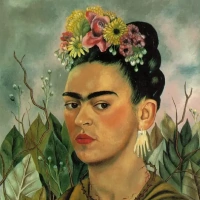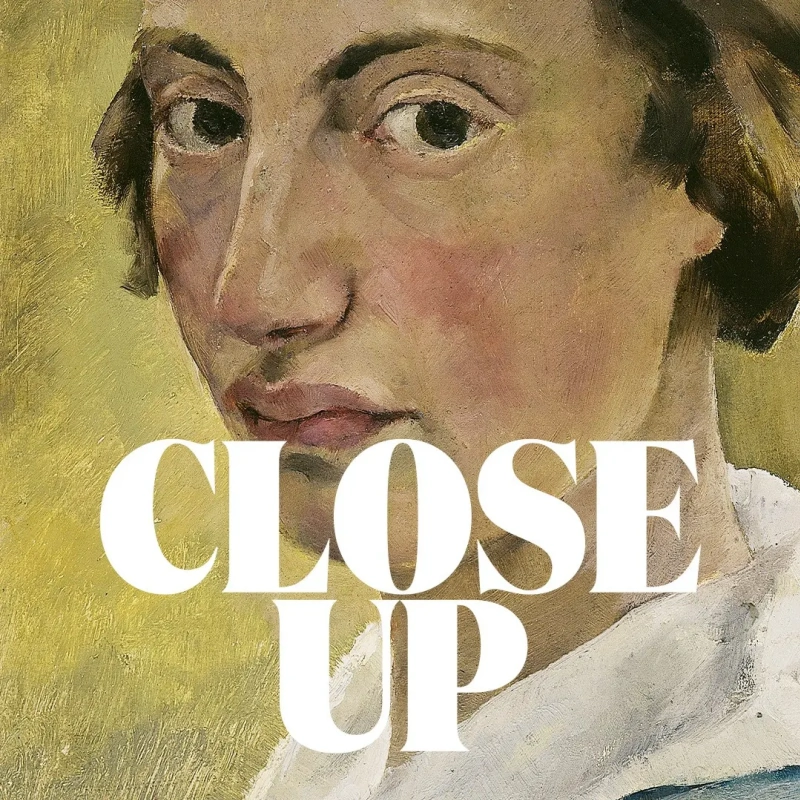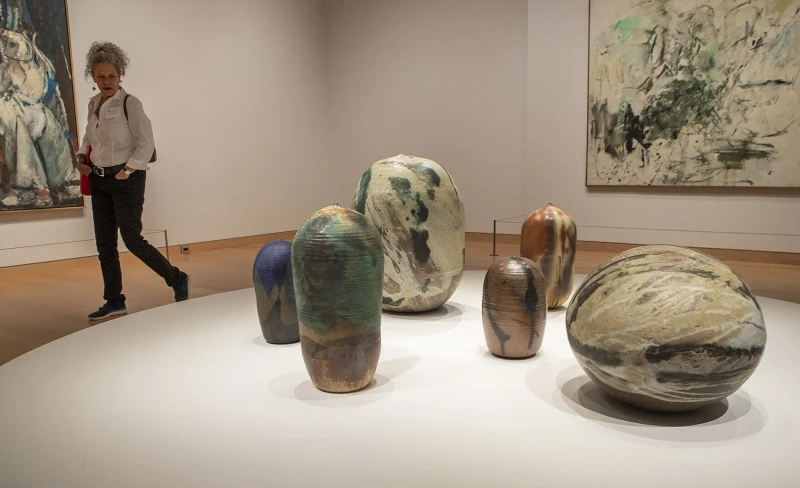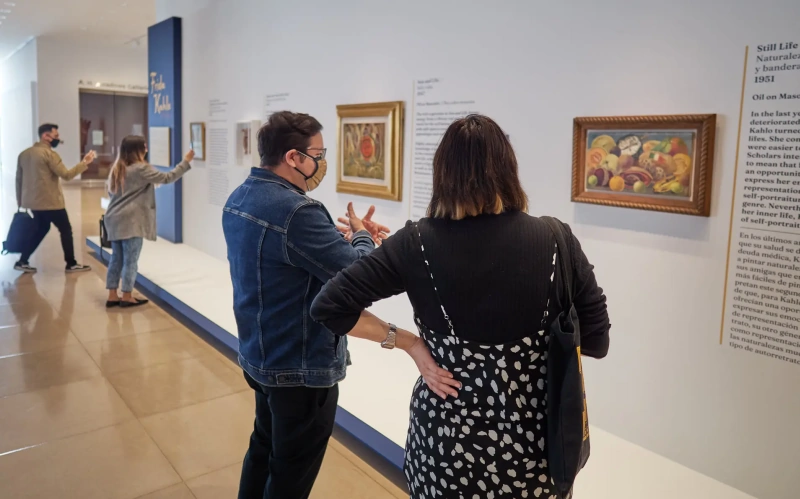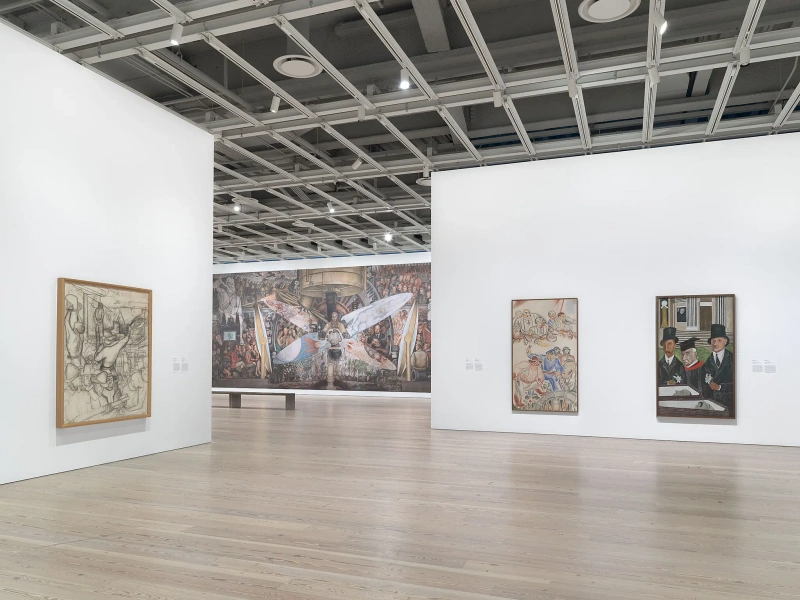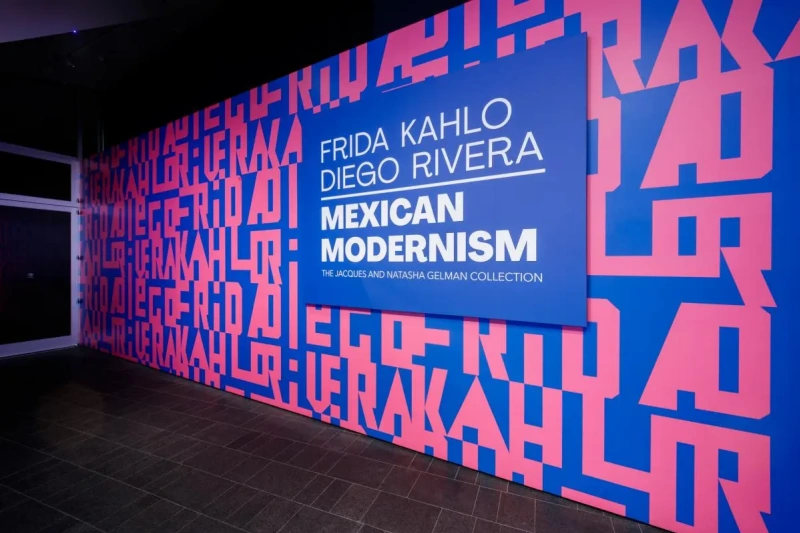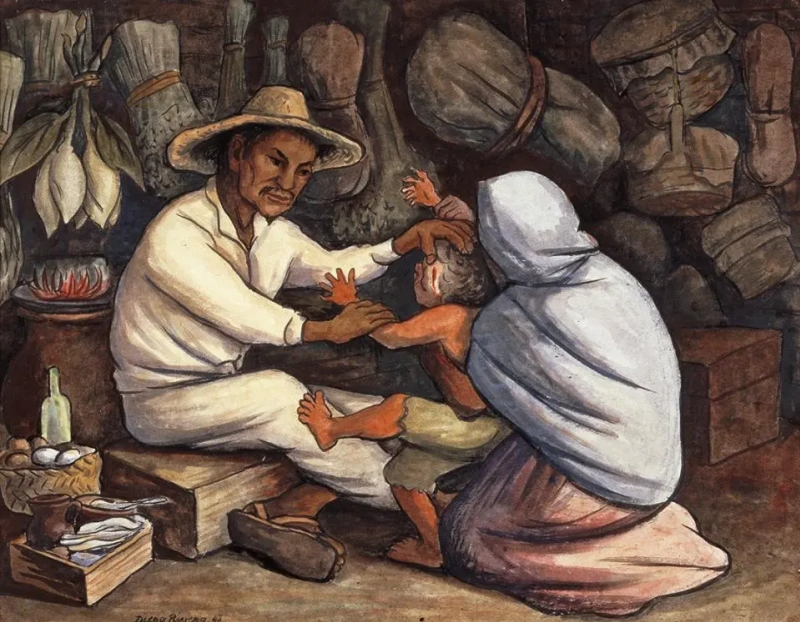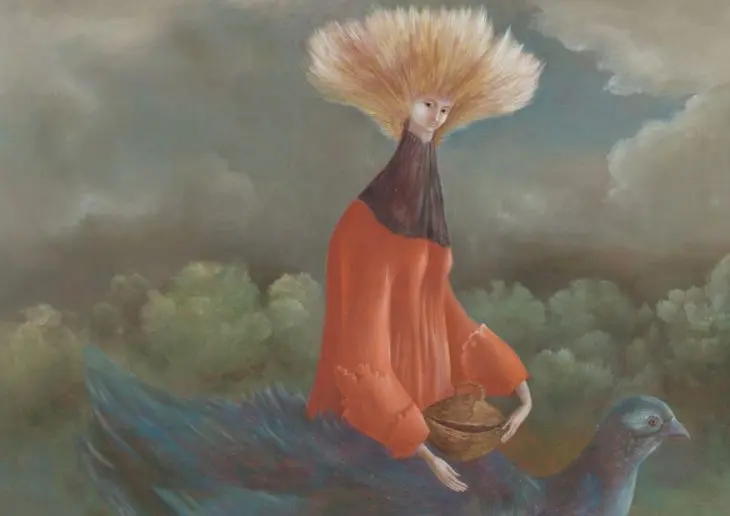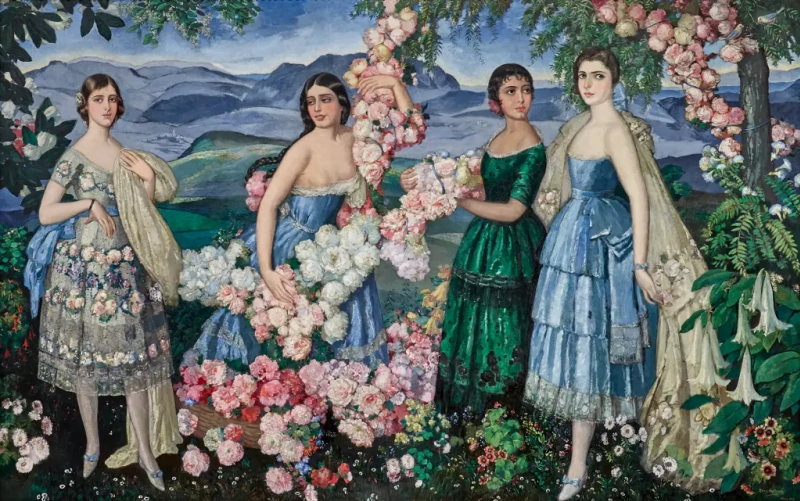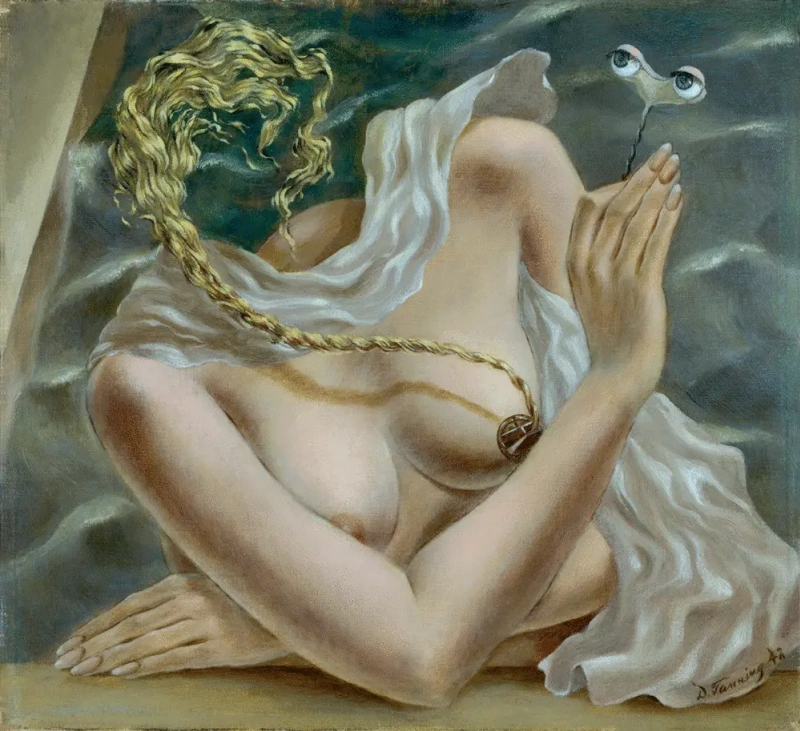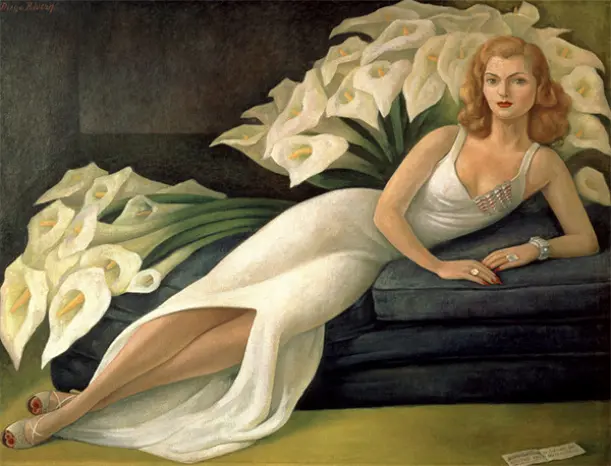log in
Enter site
Login to use Arthive functionality to the maximum
Frida Kahlo (Frida Kahlo de Rivera, 6 July 1907, Coyoacán, Mexico – 13 July 1954, Coyoacán, Mexico) is a Mexican artist, who was famed for her surreal art. When she was young she got into an accident, which set a seal on her life and rebound upon her art style. Kahlo began to paint being confined to bed. The artist became well-known in Europe (in particular, thanks to her husband Diego Rivera), but she always dreamed of recognition at home as well. The first personal exhibition of Frida in Mexico took place in 1953, shortly before her death.
Creative features of the artist Frida Kahlo: In her symbolic works, Frida mostly tells about herself, her experience, physical and mental pain. An impressive part of her art are self-portraits, in which she is usually surrounded by plants and animals. In addition, Frida often addresses the topic of sickness and death.
Famous paintings by Frida Kahlo: The Broken Column, The Two Fridas, A Few Small Nips!, The Dream (The Bed), Diego and Frida, Henry Ford Hospital (The Flying Bed), The Wounded Deer.
Mexicans are strange people, very unusual. They paint their clothes, their homes and their lives with heavenly and sunny colours, talk their special and particularly liquid Spanish, and their songs can even tug at your heartstrings. They worship Santa Muerte (“Holy Death”), and their major national holiday is the Day of the Dead, which they turn into a real triumph of life. Where else, if not here, could a person like Frida Kahlo be born?
Frida is one of those rare cases in the art world, when the popularity of the artist is mostly due to her tragic personal story overshadowing her talented works. All her biography she seemed to run a race with death, she left behind and broke through, desperately clang to her life or dreamed to leave and never return. As paradoxical as it may sound, death proved to be the most faithful companion of Kahlo during all her journey. The Crucial Point The story of Frida Kahlo should be started from her parents. It was they, who began that mortal dance long before her birth, but each of them followed his own music.
When Wilhelm Kahlo came to Mexico from Germany, he changed his name to Spanish Guillermo and quit Judaism. His first wife bore him three girls, but the middle daughter died shortly after the birth, and the woman herself did not survive the third childbirth. Guillermo remained with two children and quickly married Matilde Calderón y González. The girl had also experienced her personal tragedy by that time: Matilde’s groom committed suicide in front of her eyes. Later Frida wrote in her diary that her mother could not fully recover from this terrible loss and love her husband.
Matilde gave birth to four Guillermo’s girls (Matilde, Adriana, Frida, Cristina), and their only son died of pneumonia a few days after birth. Magdalena Carmen Frida Calderón was born on 6 July 1907. After many years, this date would seem not significant enough to Frida and she began saying that she had been born on 7 July 1910, on the beginning of the Mexican Revolution.
When the girl was six, she had muscle ache in her right leg. Despite the efforts of doctors and Guillermo Kahlo, who seriously addressed her daughter`s health, polio lamed the girl's leg and made her halt for the rest of her biography. But the real tragedy was still ahead. The girl would grow up, enter a prestigious German school, get a “gang” of loyal friends, fall in love for the first time and start making plans about medical career.
Everything collapsed on 17 September 1925, when a tram crashed into a bus, in which Frida was returning from school. The doctors doubted that the girl would survive, not to mention she would walk again: fractured pelvic bones, broken spine and many other injuries confined Frida to bed for many months, and made her feel constant pain for the rest of her biography. This was the moment, when death drew attention to her for the first time, came closer to examine her, and remained nearby all the time. At that moment, Frida’s life ended. And a very different story started. The Dance With Death One of the features of the Kahlo’s art is that they are all painted in tiny strokes. This was a serious work for her hands and spine, so you can only guess how hard it was for Frida when she just started to paint. Before the accident, her only experience in this area was several lessons from a printmaker Fernando Fernández. Her father, who earned his living making photos, bought her the first brushes and paints. And the mother brought her a stretcher to help her paint lying. Her works of that time are mostly still lives and self-portraits. After years, Kahlo would say that she painted so many self-portraits, because her own face was what she knew best of all. In those months, when Frida was recovering from the accident, she was afraid of dying and fading from people’s memory, that’s why she tried to leave as many reminders about herself as possible. Her first such work was Self-Portrait in a Velvet Dress (1926).
One more thing that distinguishes the pictures by Frida Kahlo de Rivera is their deep emotionality. All that she could not put into words, and all that she had to be silenced about, Kahlo transferred on her canvas. She showed the viewer blood, pain, guts, and the ugly truth. Frida shared her feelings about constant cheating of her husband, the famous painter Diego Rivera (A Few Small Nips!, 1935), suffering from another loss of the child (Henry Ford Hospital, 1932) and the continuous pain of her injuries, diseases and countless surgeries (The Broken Column, 1944, Without Hope, 1945, The Wounded Deer, 1946). And all the time, Kahlo mercilessly revealed her soul, just as doctors opened up her exhausted body again and again, and demonstrated to the spectator her own open heart, sensitive and defenceless (The Two Fridas, 1939).
And, finally, Frida would not have been Frida if she had not inherited the Mexican attitude toward death, based both on respect and a good pinch of humour. An integral part of culture of Mexico are the so-called "retablos", primitive pictures on small sheets of tin, drawn in gratitude for the saints (Diego and Frida collected a huge collection of such images). In particular, retablos were the source of different death images which we can see on Kahlo’s artworks. It is standing tall at the square in Coyoacán not far from her house (Four Inhabitants of Mexico, 1938), staring through the empty eye sockets of the mask on a small girl wearing pink dress (Girl with Death Mask, 1938), and waiting in the wings with a smile over the Frida Kahlo’s bed while she is sleeping (The Dream (The Bed), 1940). This was the only way the artist escaped from the fear convinced by this permanent invisible presence. Viva La Vida! Frida had to chase popularity in her Mexico for a long time, despite the fact that back in 1938 she made a lot of noise in New York, where the first solo exhibition of her artworks at the Julien Levy gallery took place. Initially, critics were sceptical towards “Mrs. Rivera”, though were fascinated by her and the originality of her paintings.
Soon after, the painter went to Paris at the invitation of Andre Breton, who had promised the artist to arrange her personal exhibition. They met during the visit of Breton and his wife Jacqueline Lamba to Mexico. According to information, the poet and the painter were amazed by the Frida’s works, in particular, by the unfinished work What The Water Gave Me (1938), and told the artist that she painted in the style of surrealism, which surprised her much. However, despite the Breton’s promises, the facts are that the organization of the exhibition of her artworks has never started. Frida only learned of it after she had arrived to Paris, so she was very angry with Breton and began to call the Parisian surrealists coocoo lunatic sons of bitches.
Frida Kahlo de Rivera felt very uncomfortable far away from her native Mexico. Neither New York nor Paris impressed her, she was longing for her Blue House, where she was born and lived almost all her life, for her Diego. They moved away and came back, quarrelled and reconciled, divorced and remarried, they were living in two different houses connected by a thin bridge. In the meantime, the torn in pieces Frida Kahlo’s body was put together with the help of metal corsets, numerous surgeries, and medications.
The first solo exhibition of Frida Kahlo in Mexico only took place in 1953. By that time the artist was already bedridden and was under strong painkillers and alcohol at all times. But she could not miss such an important fact in her biography. During the opening of the exhibition, Frida was brought to the gallery of contemporary art on a stretcher and laid on a bed in the centre of the hall among her artworks.
In her latest years, it was getting harder for Frida Kahlo to create her art. Kahlo was right back where she started, she was painting still lives, lying on the bed. The artwork Viva La Vida! Watermelons (1954) is considered the last work by Frida, however, going by clear lines and confident smears, it was painted long before. The final touch was just the inscription of blood-red paint as if carved on the ripe watermelon pulp. "Viva La Vida!" – "Hurray For Life!" What else could Frida Kahlo de Rivera, who was already facing the death, write, if not this defiant challenge?
Author: Yevheniia Sidelnikova
Leer más
Creative features of the artist Frida Kahlo: In her symbolic works, Frida mostly tells about herself, her experience, physical and mental pain. An impressive part of her art are self-portraits, in which she is usually surrounded by plants and animals. In addition, Frida often addresses the topic of sickness and death.
Famous paintings by Frida Kahlo: The Broken Column, The Two Fridas, A Few Small Nips!, The Dream (The Bed), Diego and Frida, Henry Ford Hospital (The Flying Bed), The Wounded Deer.
Mexicans are strange people, very unusual. They paint their clothes, their homes and their lives with heavenly and sunny colours, talk their special and particularly liquid Spanish, and their songs can even tug at your heartstrings. They worship Santa Muerte (“Holy Death”), and their major national holiday is the Day of the Dead, which they turn into a real triumph of life. Where else, if not here, could a person like Frida Kahlo be born?
Frida is one of those rare cases in the art world, when the popularity of the artist is mostly due to her tragic personal story overshadowing her talented works. All her biography she seemed to run a race with death, she left behind and broke through, desperately clang to her life or dreamed to leave and never return. As paradoxical as it may sound, death proved to be the most faithful companion of Kahlo during all her journey. The Crucial Point The story of Frida Kahlo should be started from her parents. It was they, who began that mortal dance long before her birth, but each of them followed his own music.
When Wilhelm Kahlo came to Mexico from Germany, he changed his name to Spanish Guillermo and quit Judaism. His first wife bore him three girls, but the middle daughter died shortly after the birth, and the woman herself did not survive the third childbirth. Guillermo remained with two children and quickly married Matilde Calderón y González. The girl had also experienced her personal tragedy by that time: Matilde’s groom committed suicide in front of her eyes. Later Frida wrote in her diary that her mother could not fully recover from this terrible loss and love her husband.
Matilde gave birth to four Guillermo’s girls (Matilde, Adriana, Frida, Cristina), and their only son died of pneumonia a few days after birth. Magdalena Carmen Frida Calderón was born on 6 July 1907. After many years, this date would seem not significant enough to Frida and she began saying that she had been born on 7 July 1910, on the beginning of the Mexican Revolution.
When the girl was six, she had muscle ache in her right leg. Despite the efforts of doctors and Guillermo Kahlo, who seriously addressed her daughter`s health, polio lamed the girl's leg and made her halt for the rest of her biography. But the real tragedy was still ahead. The girl would grow up, enter a prestigious German school, get a “gang” of loyal friends, fall in love for the first time and start making plans about medical career.
Everything collapsed on 17 September 1925, when a tram crashed into a bus, in which Frida was returning from school. The doctors doubted that the girl would survive, not to mention she would walk again: fractured pelvic bones, broken spine and many other injuries confined Frida to bed for many months, and made her feel constant pain for the rest of her biography. This was the moment, when death drew attention to her for the first time, came closer to examine her, and remained nearby all the time. At that moment, Frida’s life ended. And a very different story started. The Dance With Death One of the features of the Kahlo’s art is that they are all painted in tiny strokes. This was a serious work for her hands and spine, so you can only guess how hard it was for Frida when she just started to paint. Before the accident, her only experience in this area was several lessons from a printmaker Fernando Fernández. Her father, who earned his living making photos, bought her the first brushes and paints. And the mother brought her a stretcher to help her paint lying. Her works of that time are mostly still lives and self-portraits. After years, Kahlo would say that she painted so many self-portraits, because her own face was what she knew best of all. In those months, when Frida was recovering from the accident, she was afraid of dying and fading from people’s memory, that’s why she tried to leave as many reminders about herself as possible. Her first such work was Self-Portrait in a Velvet Dress (1926).
One more thing that distinguishes the pictures by Frida Kahlo de Rivera is their deep emotionality. All that she could not put into words, and all that she had to be silenced about, Kahlo transferred on her canvas. She showed the viewer blood, pain, guts, and the ugly truth. Frida shared her feelings about constant cheating of her husband, the famous painter Diego Rivera (A Few Small Nips!, 1935), suffering from another loss of the child (Henry Ford Hospital, 1932) and the continuous pain of her injuries, diseases and countless surgeries (The Broken Column, 1944, Without Hope, 1945, The Wounded Deer, 1946). And all the time, Kahlo mercilessly revealed her soul, just as doctors opened up her exhausted body again and again, and demonstrated to the spectator her own open heart, sensitive and defenceless (The Two Fridas, 1939).
And, finally, Frida would not have been Frida if she had not inherited the Mexican attitude toward death, based both on respect and a good pinch of humour. An integral part of culture of Mexico are the so-called "retablos", primitive pictures on small sheets of tin, drawn in gratitude for the saints (Diego and Frida collected a huge collection of such images). In particular, retablos were the source of different death images which we can see on Kahlo’s artworks. It is standing tall at the square in Coyoacán not far from her house (Four Inhabitants of Mexico, 1938), staring through the empty eye sockets of the mask on a small girl wearing pink dress (Girl with Death Mask, 1938), and waiting in the wings with a smile over the Frida Kahlo’s bed while she is sleeping (The Dream (The Bed), 1940). This was the only way the artist escaped from the fear convinced by this permanent invisible presence. Viva La Vida! Frida had to chase popularity in her Mexico for a long time, despite the fact that back in 1938 she made a lot of noise in New York, where the first solo exhibition of her artworks at the Julien Levy gallery took place. Initially, critics were sceptical towards “Mrs. Rivera”, though were fascinated by her and the originality of her paintings.
Soon after, the painter went to Paris at the invitation of Andre Breton, who had promised the artist to arrange her personal exhibition. They met during the visit of Breton and his wife Jacqueline Lamba to Mexico. According to information, the poet and the painter were amazed by the Frida’s works, in particular, by the unfinished work What The Water Gave Me (1938), and told the artist that she painted in the style of surrealism, which surprised her much. However, despite the Breton’s promises, the facts are that the organization of the exhibition of her artworks has never started. Frida only learned of it after she had arrived to Paris, so she was very angry with Breton and began to call the Parisian surrealists coocoo lunatic sons of bitches.
Frida Kahlo de Rivera felt very uncomfortable far away from her native Mexico. Neither New York nor Paris impressed her, she was longing for her Blue House, where she was born and lived almost all her life, for her Diego. They moved away and came back, quarrelled and reconciled, divorced and remarried, they were living in two different houses connected by a thin bridge. In the meantime, the torn in pieces Frida Kahlo’s body was put together with the help of metal corsets, numerous surgeries, and medications.
The first solo exhibition of Frida Kahlo in Mexico only took place in 1953. By that time the artist was already bedridden and was under strong painkillers and alcohol at all times. But she could not miss such an important fact in her biography. During the opening of the exhibition, Frida was brought to the gallery of contemporary art on a stretcher and laid on a bed in the centre of the hall among her artworks.
In her latest years, it was getting harder for Frida Kahlo to create her art. Kahlo was right back where she started, she was painting still lives, lying on the bed. The artwork Viva La Vida! Watermelons (1954) is considered the last work by Frida, however, going by clear lines and confident smears, it was painted long before. The final touch was just the inscription of blood-red paint as if carved on the ripe watermelon pulp. "Viva La Vida!" – "Hurray For Life!" What else could Frida Kahlo de Rivera, who was already facing the death, write, if not this defiant challenge?
Author: Yevheniia Sidelnikova
-
Las obras han gustado531 users
- Artworks in 6 collections and 333 selections
出版物
展览
画家的所有展览
Self-portrait with a parrot
1940-第
, 24×19 厘米

纪念(心)
1937

我的出生
1932, 30×35 厘米

自画像红色的帽子
1932

弗里达和剖腹产(段)
1931, 62×73 厘米

弗里达和剖腹产(进展中的工作)
1931, 62×73 厘米

裸体阿迪韦伯(我的表弟)
1930, 62×48 厘米

自画像
1929, 77.5×61 厘米

一位夫人的画象白色的
1929, 118.1×81.3 厘米

The Deceased Dimas
1937, 48×31 厘米

Self Portrait - The Frame
1938, 28.5×20.7 厘米

Sleep (Bed)
1940, 74×98.5 厘米
消息
Close-upexhibition finished

19 九月 2021 − 2 一月 2022 该博物馆基金会Beyeler, Basel, Switzerland, Baselstrasse, 101
